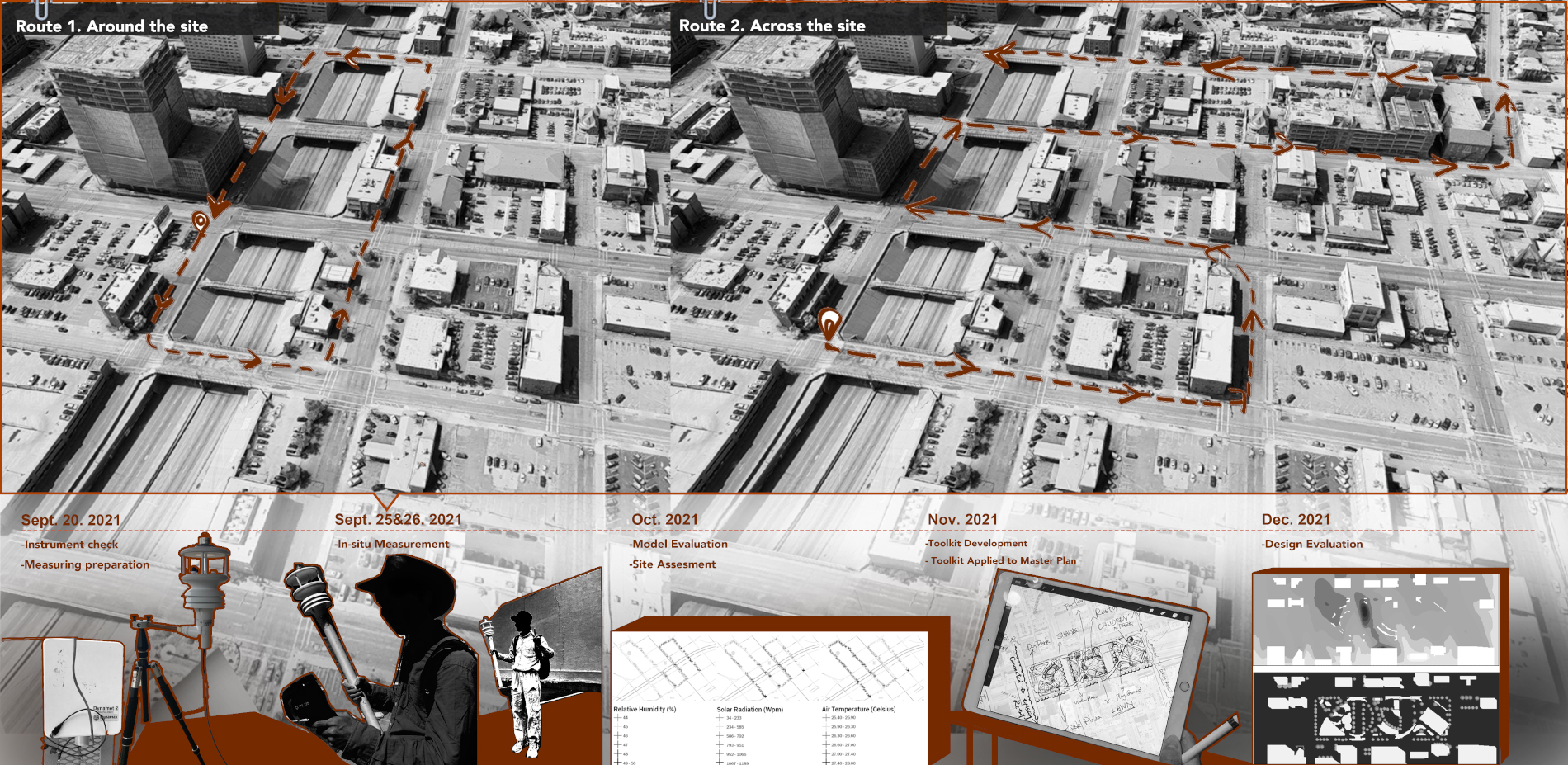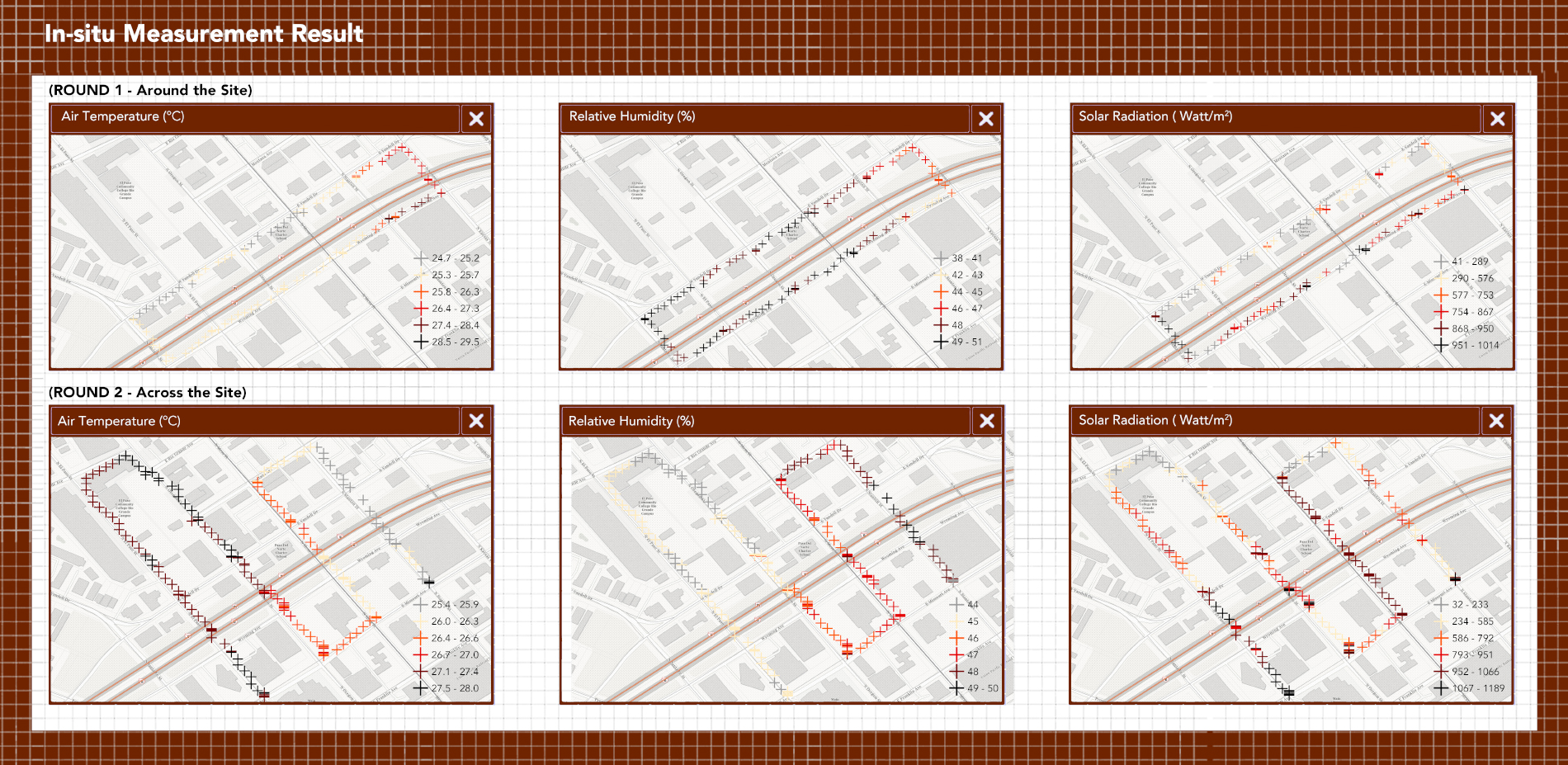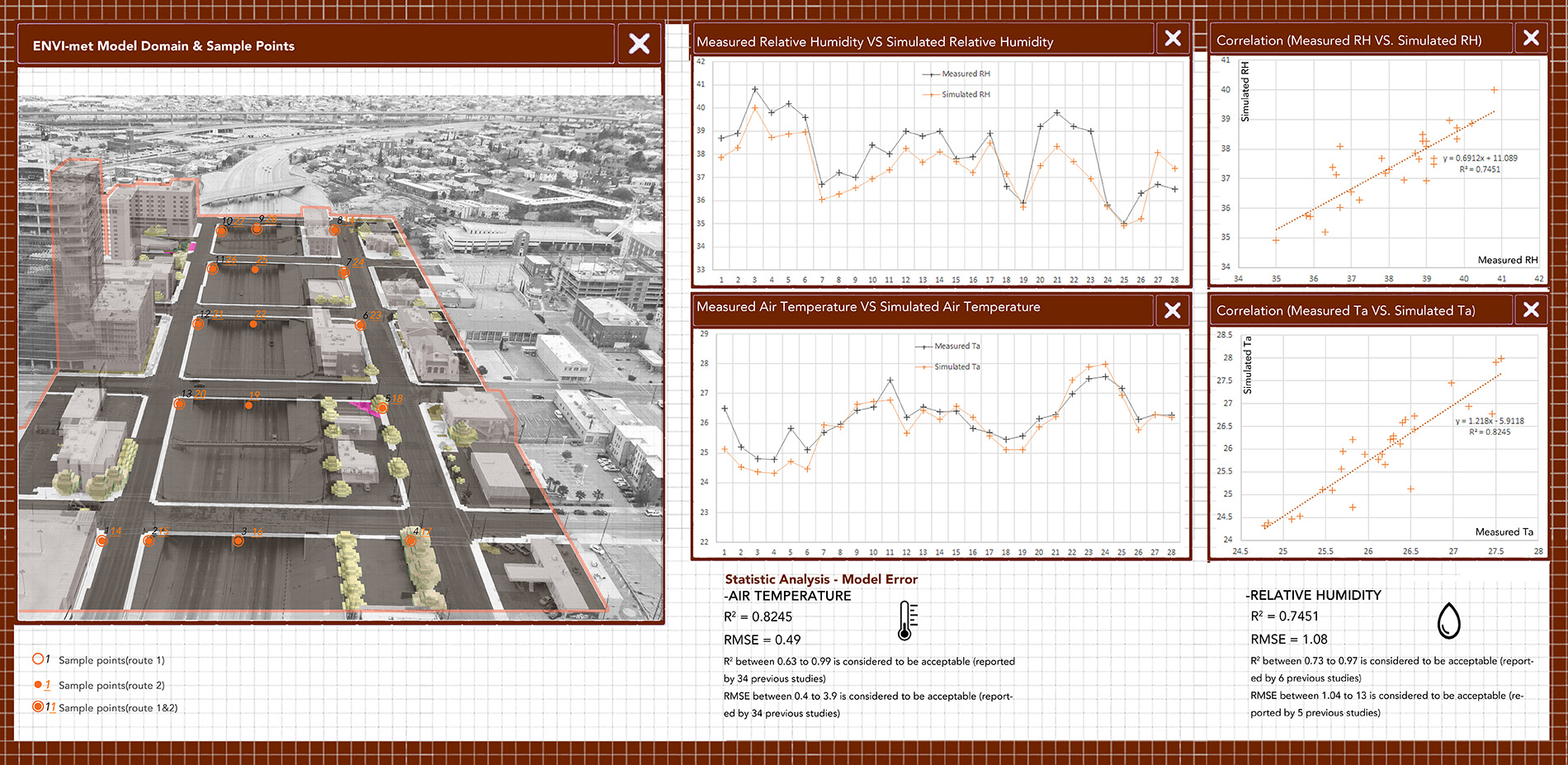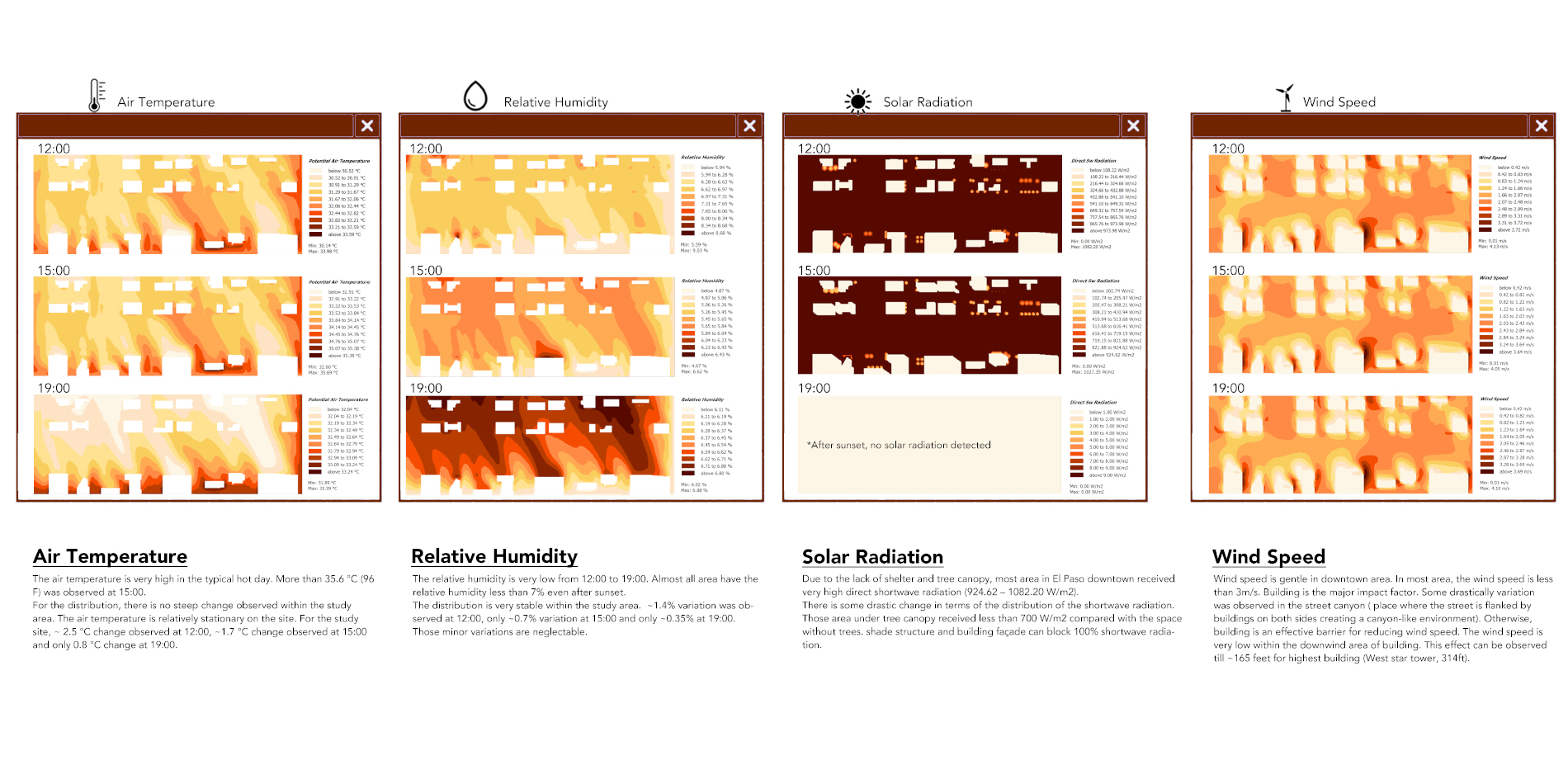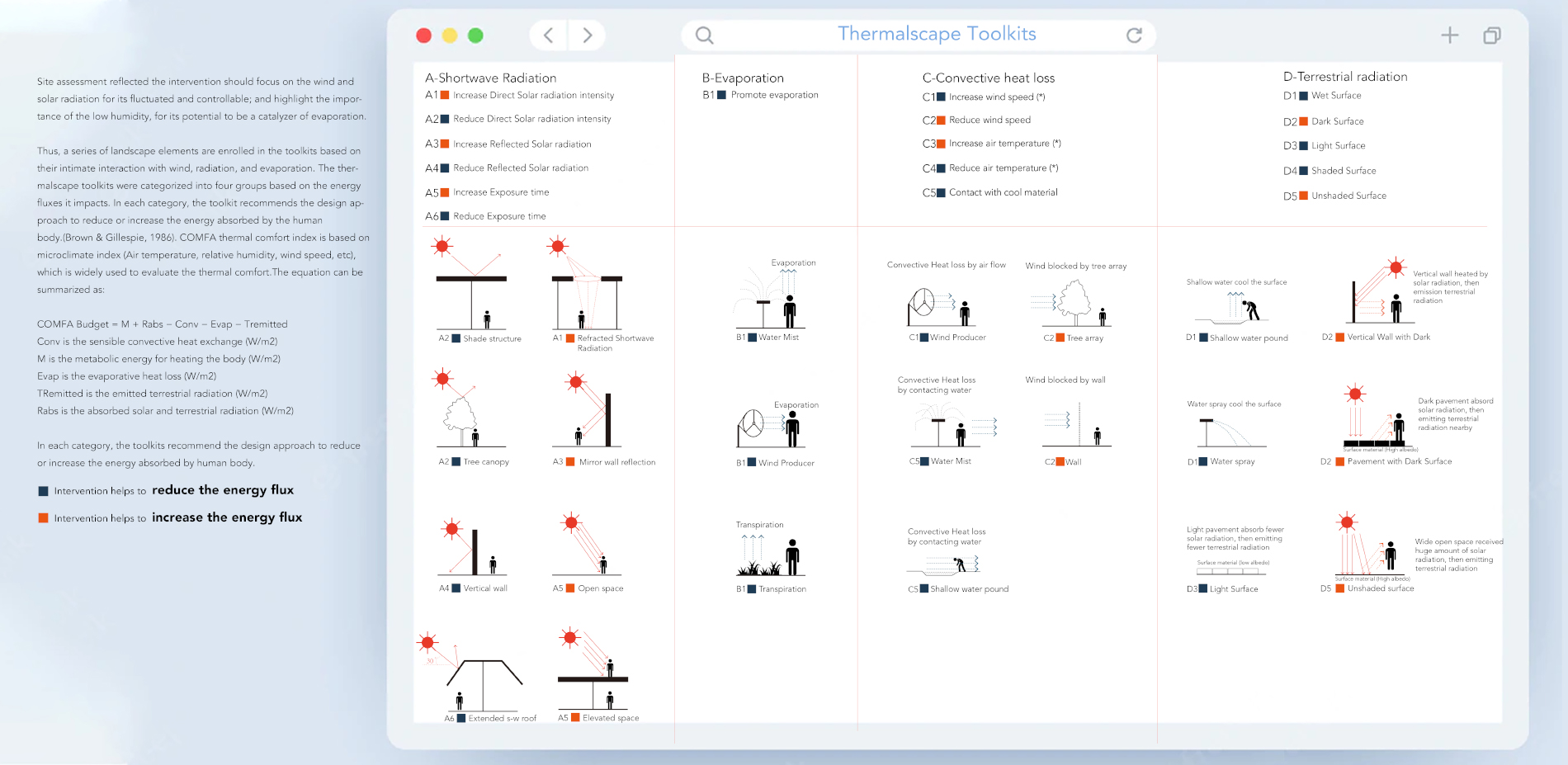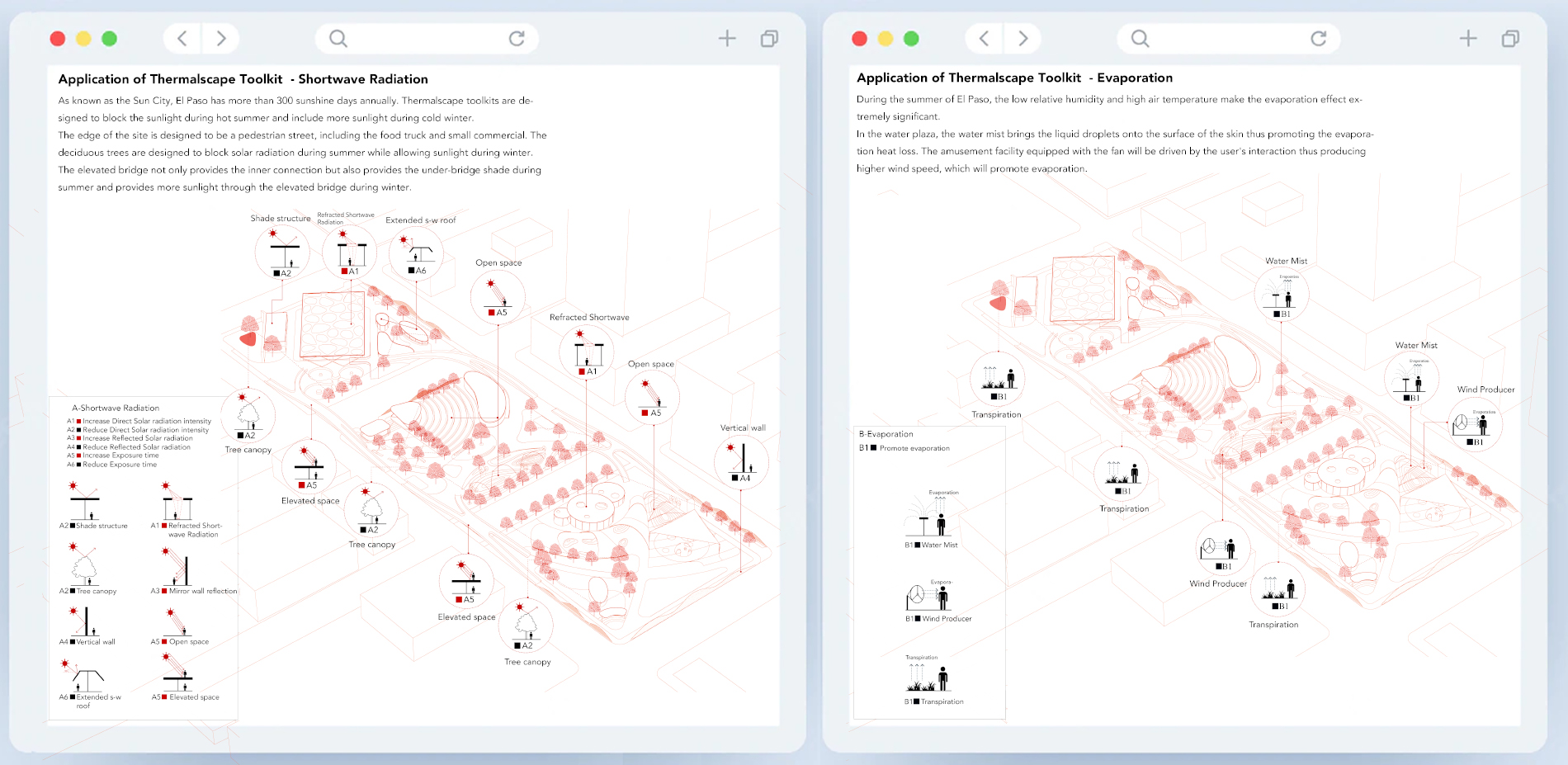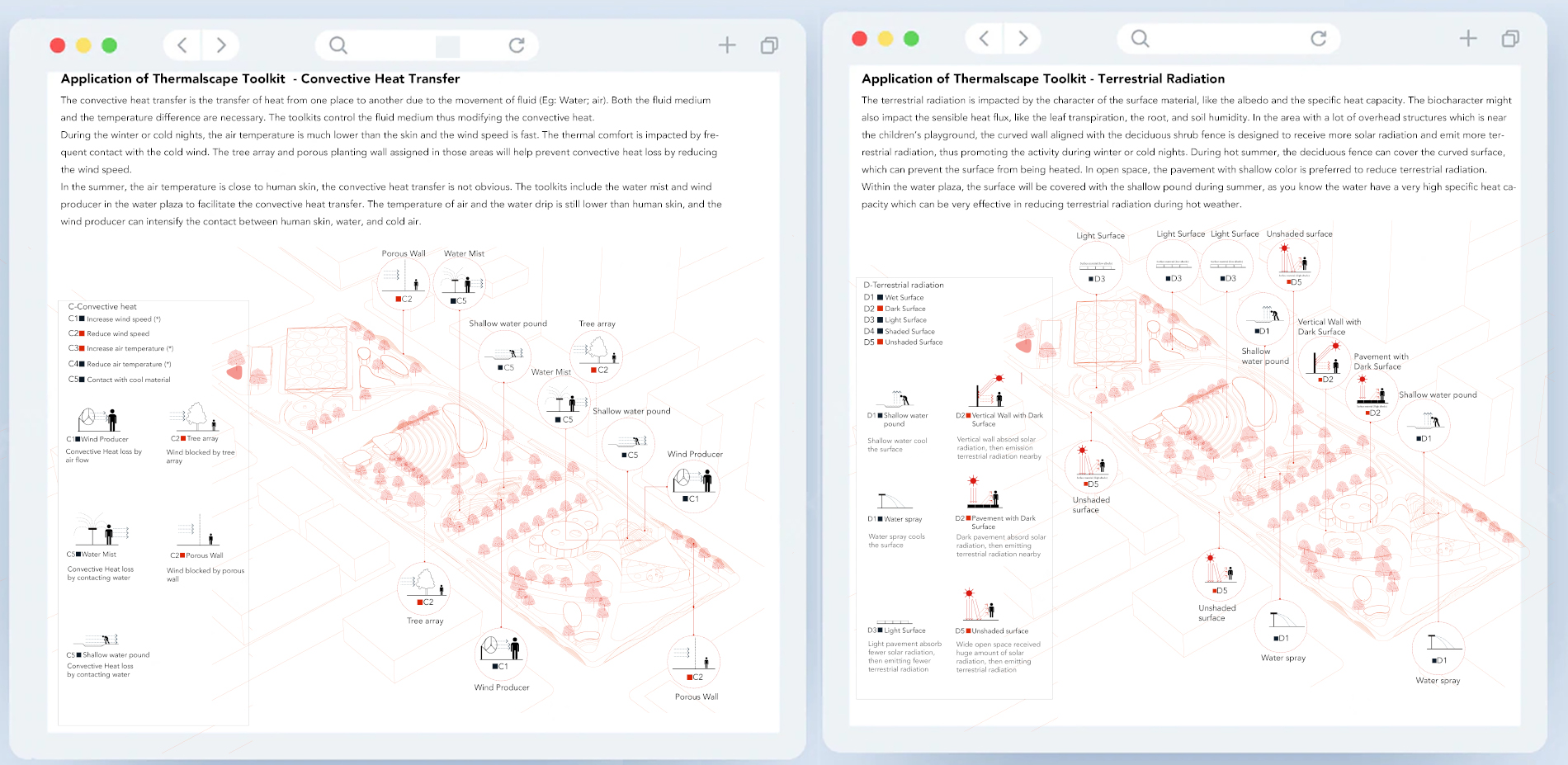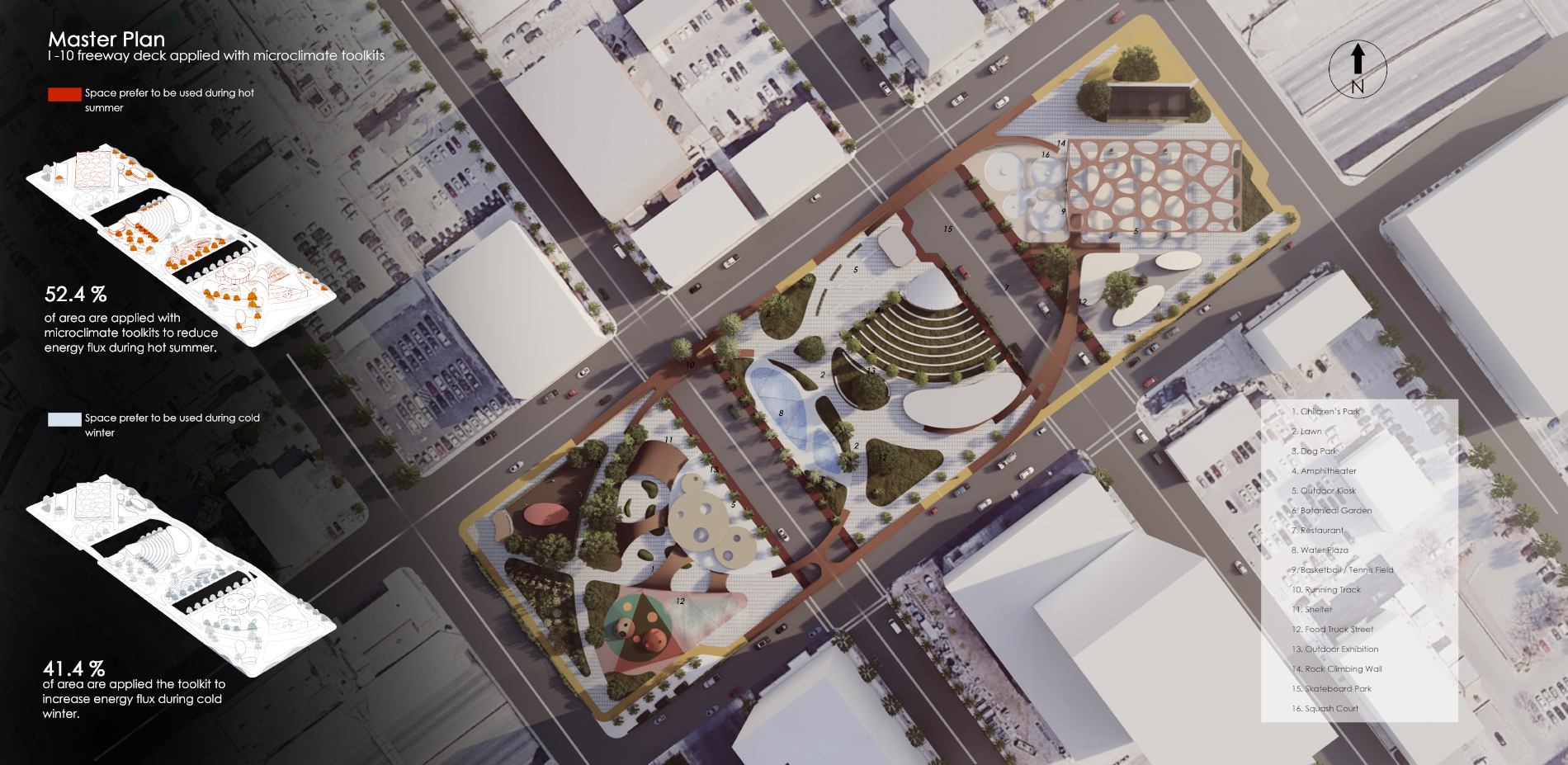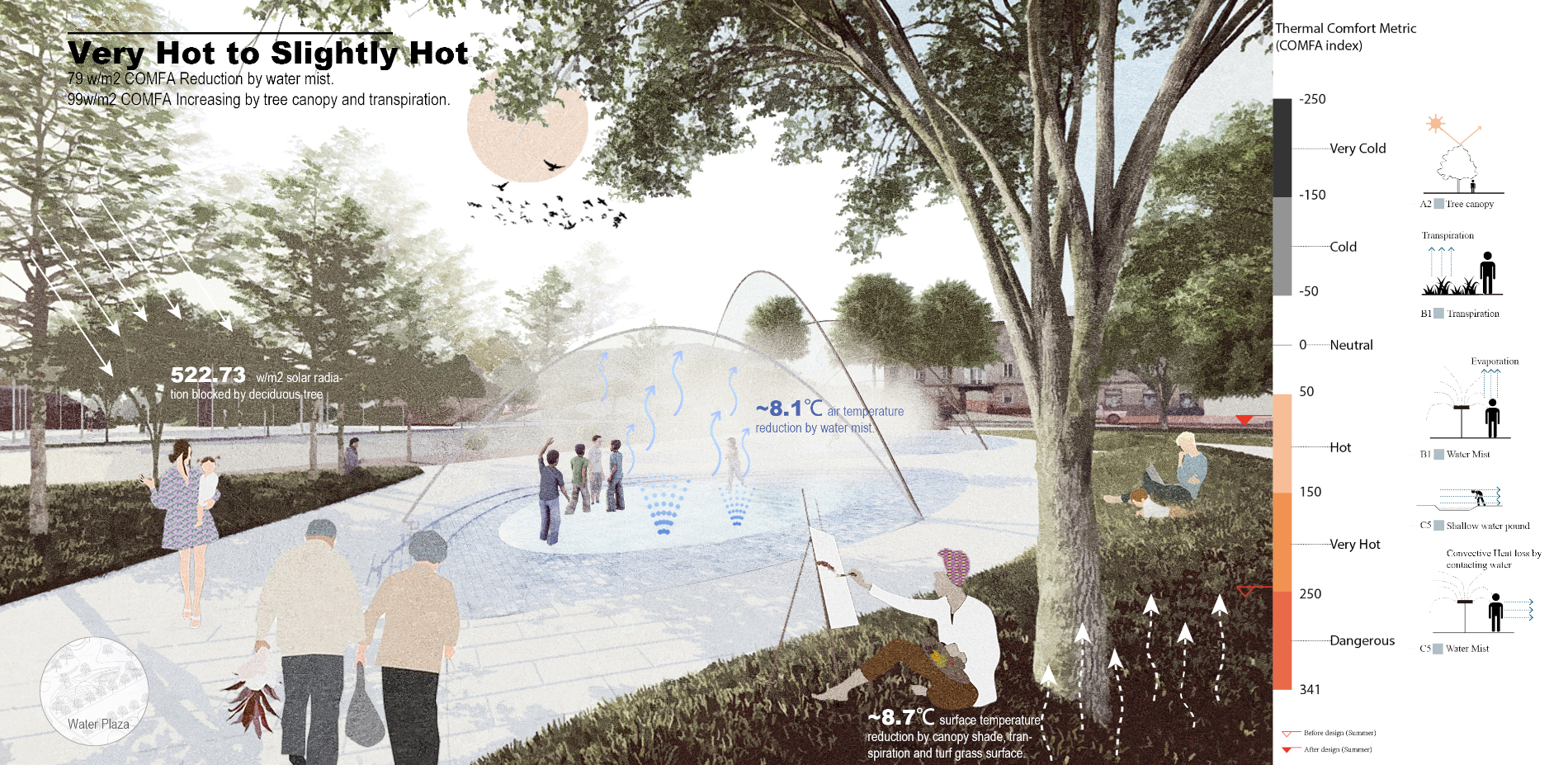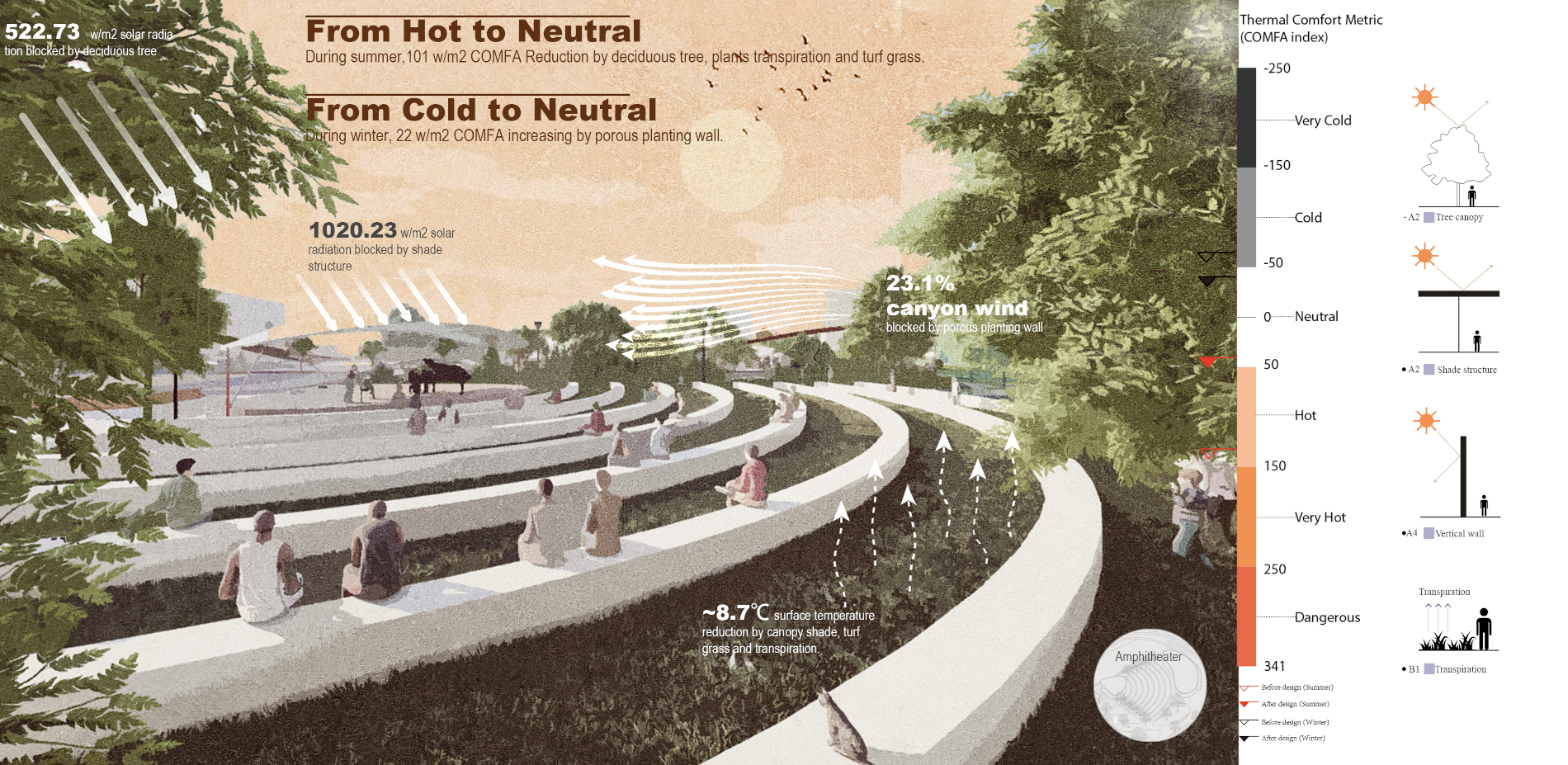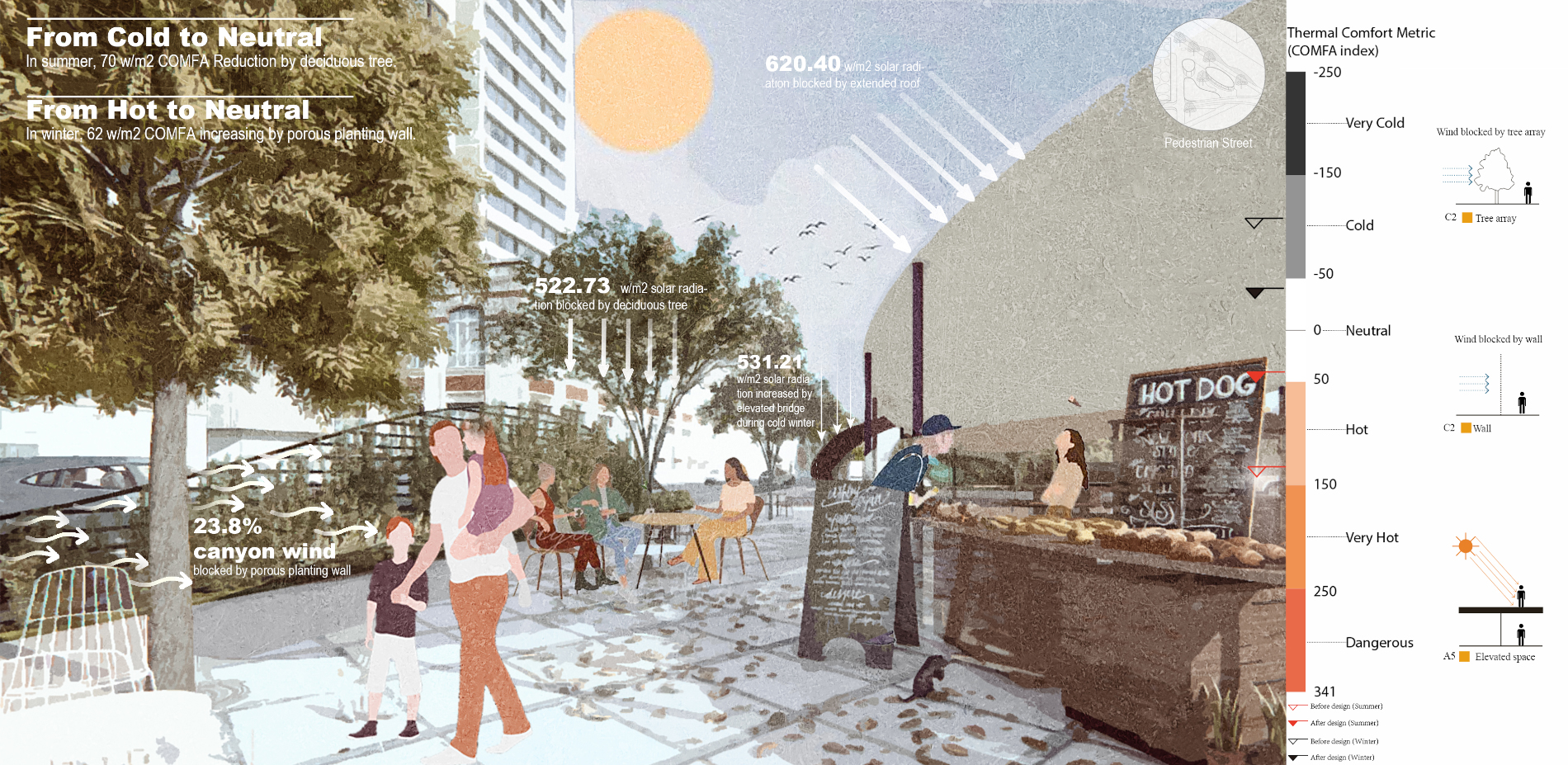Thermalscape Tactics – Solutions in Response to Ubiquitous Heat Threat in El Paso
Honor Award
Research
El Paso, Texas, United States
Xiaoyu Li, Student ASLA;
Jingxi Peng;
Faculty Advisors:
Robert Brown, FASLA;
Dongying Li, FASLA;
Kirk Hamilton;
Texas A&M University
Extreme heat is a significant concern for public health. This project explored how site-scale landscape elements could be used to mitigate extreme heat and cold threats in a dry desert climate. A simulation model was developed to test the thermal effectiveness of various design strategies within a proposed park in El Paso, TX. The final outcome was a thermalscape toolkit that could be potentially calibrated for use in different climates.
- 2022 Awards Jury
Project Statement
Global climate change affects different geographies and populations disproportionately. El Paso, a Hispanic majority city located in the hot desert climate zone, experiences increasing frequencies of extreme heat. Annual temperatures is 3 degrees warmer than the same period a century earlier, and the hottest monthly average temperature could reach 98 F, indicating the severe heat threat.
Despite the recognition of climate change adaptation in the design disciplines and high-level planning efforts, site-scale methodologies to mitigate extreme heat have been scarce. As a means of responding to the heat threat, this project establishes and evaluates thermalscape tactics as an applicable framework to address the heat threats and mitigate the impacts on vulnerable user groups. The project investigated the heat threat in downtown El Paso through field micrometeorological measurements and three-dimensional simulation. Thermalscape tactics reconceptualize functionalities of landscape elements that deliver adaptability in ambient heat regulation; subsequently, thermalscape toolkits are developed and applied to the I-10 freeway deck park project. As a methodology of quantitative evaluation, additional simulations were conducted to reveal the performance of the nterventions.
Project Narrative
1. Background
With the drastic macroclimatic change, we are conscripted to behave toward the thermal threat. In El Paso, the extremely hot days are irreversibly increasing, which has approximately tripled in nearly 20 years. Fortunately, the microclimate is malleable and might be able to provide solutions. The microclimate is the condition of the solar and terrestrial radiation, wind, air temperature, humidity, and precipitation in a small outdoor space (Brown and Gillespie, 1995). There is a long history that microclimate indicators play a key role in fields like horticulture, pomology, and greenhouse farming, but are not yet a priority in the field of landscape architecture (Brown, 2015). With the development of numerical simulation, the field of landscape architecture is stepping up to embrace the microclimatic and thermal comfort data streams into the design process through three-dimensional modeling (Panagopoulos, 2008). Thermalscape tactics exemplify how landscape elements may impact various energy fluxes on site that together determine the microclimate conditions and human lived experience. It is integrated into daily life in a way acceptable and beneficial to the public, providing suitable outdoor space for local residents in extreme weather and establishing a healthy living environment.
2. Research framework
1). Micrometeorological assessment: Comparing the in-situ measurement and ENVI-met simulation results, to evaluate the accuracy of numerical simulation. The in-situ measurement was conducted on Sept.26, 2021 using compact weather station MaxiMET GMX501. The regression analysis was conducted to examine the error between measured microclimate data and simulated microclimate data (Sun, 2017). The model parameters were adjusted repeatedly until the simulation results were within the acceptable range.
2). Simulations of extreme heat and cold conditions: To reconstruct the conditions on extreme heat and cold days, the simulation was conducted again via the validated ENVI-met models, which reconstruct the three-dimensional environment and calculates the thermal parameters mathematically. The output of June.10.2020 (a typical extreme hot day), and Feb.15.2020 (a typical cold day) worked as the microclimate indicators of typical days in El Paso. The site assessment includes a series of microclimate indicators, such as air temperature, wind speed, relative humidity, and solar radiation, which jointly affect human energy exchange with the environment and risks of heat morbidity/mortality. Results indicated that extreme high solar radiation (exceeds 1000 w/m2) and air temperature (reaches 96 F) to be the major impactor that contributes to extreme heat threat during the hottest hours. In addition, relative humidity is less than 5% in some areas, which is far below the average level in Texas. Except for the heat threat, the unexpected drastic diurnal temperature variation also came into the picture. Before and after sunset, the difference in temperature could reach 35 ℉, leading to challenges to prepare, especially for disadvantaged families living in substandard housing conditions. This threat could be amplified by urban canyon wind via the convective heat transfer process. The numerical simulation as microclimate assessment provides the basic knowledge via a comprehensive analysis including both temporal and spatial distribution, working as an indispensable step of the thermalscape tactics.
3). Thermalscape Tactics Deployment: Site assessment revealed that solar radiation, air temperature, and wind speed being the most critical risk factors, while design simulations showed that while air temperature control requires large-scale interventions, site-level design can effectively impact solar radiation and wind speed. Therefore, a series of landscape elements are integrated into the thermalscape tactics, which focus on dynamic adjustments of wind and solar radiation, and utilizing current low humidity as a catalyzer of evaporation. The tactics were categorized into four groups based on the energy fluxes it impacts, namely, shortwave radiation, evaporation, convective heat transfer, and terrestrial radiation. In each category, the toolkit recommends the design approach to reduce or increase the energy absorbed by the human body.
Guided by the tactics, the I-10 freeway deck park design features include the deciduous tree canopy, wind producer (User-interactive installation), water element, multiple surface material, sun path-based shade structure, and windbreak comprised of porous wall and arrayed plants. Under extreme heat conditions, the sun-path-based shade structure efficiently blocks the intense solar radiation in the afternoon, meanwhile, wind producers allow the cool wind breeze to promote evaporation and convective heat transfer. The selected surface material includes shallow ponds, turfgrass, and low albedo pavers, which combine the high specific heat capacity and plant transpiration, to create a cool surface thus reducing the terrestrial radiation. During winter seasons, the elevated bridge allows users to receive more solar radiation. The porous planting wall located on the edge of the site blocks the urban canyon wind, the multi-direction vertical wall further disturbs the wind field, to reduce the convective heat loss during the cold time.
4). Thermalscape Performance: After applying the thermalscape tactics, ENVI-met simulation was conducted again to evaluate the microclimate condition before and after the application of intervention toolkits. The intervention result works as a way of design reflection, contributing to the comprehensive understanding of the thermalscape tactics in response to the heat threats.
3. Effectiveness of thermalscape interventions
1). The ENVI-met output and the in-site measured data reached a good fit (Air temperature, R2 = 0.8575, RMSE = 0.49. For relative humidity, R2 = 0.7987, RMSE = 1.08), indicating that numerical simulation conducted by ENVI-met is trustworthy and could provide a comprehensive assessment of the microclimate condition.
2). After the intervention, the air temperature across the site reduced by 0.67℃, and the relative humidity increased by 0.30%.
3). The solar radiation and wind are more sensitive to landscape elements, which showed significant changes post microclimate landscape design. After the intervention, the average wind speed reduced by 17.2% (22.8% - 30.2% in the focused area), and the average solar radiation reduced by 25.2%.
4). Thermalscape toolkits could effectively impact the thermal comfort level. In terms of heat threat, thermalscape toolkits focused on reducing solar radiation and promoting evaporation, and most of the focus areas achieved thermal neutral after the intervention. As this design not only focus on heat conditions but also propose strategies for mitigating cold events, with reductions of north wind during winter and solar radiation promotion, most of the site reached thermally neutral conditions after the intervention.
4. Implications
In the context of a city with dry desert climate, the deployment of thermalscape tactics exemplifies how landscape elements could be applied on the microscale as an intervention tool in response to heat & cold threats. The microclimate assessment spontaneously reveals a kind of duality: a built environment under the severe heat threat might also be vulnerable to cold winter. In the I-10 freeway deck project, hot stress and cold stress are considered as a juxtaposition instead of a dichotomy. During summer, the clear sky and intense solar radiation bring extreme heat threat, while the cold air after sunset amplified by urban canyon lead the excessive energy loss during winter. The juxtaposition between hot and cold threats implies the necessity of developing the microscale thermalscape tactics, meanwhile, indicating the importance of microclimate simulation via three-dimensional model as scenario-based design method. Simultaneously, by comparing the before and after scenarios, the research project demonstrated the efficiency of thermalscape toolkits as the intervention to create adaptive microclimate environment and promote thermal health. Although it’s hard to assure the efficiency of such strategies when applied to other regions considering the climate heterogeneity, the thermalscape tactics provide a methodological framework that could be utilized to develop site-appropriate interventions based on local micrometeorological conditions.
Plant List:
- Honey Mesquite (Prosopis gladulosa)
- Live Oak (Quercus virginiana)
- Century Plant (Agave americana)
- False Yucca (Hesperaloe parviflora)
- Desert Willow (Chilopsis linearis)
- Siberian elm (Ulmus pumila)


